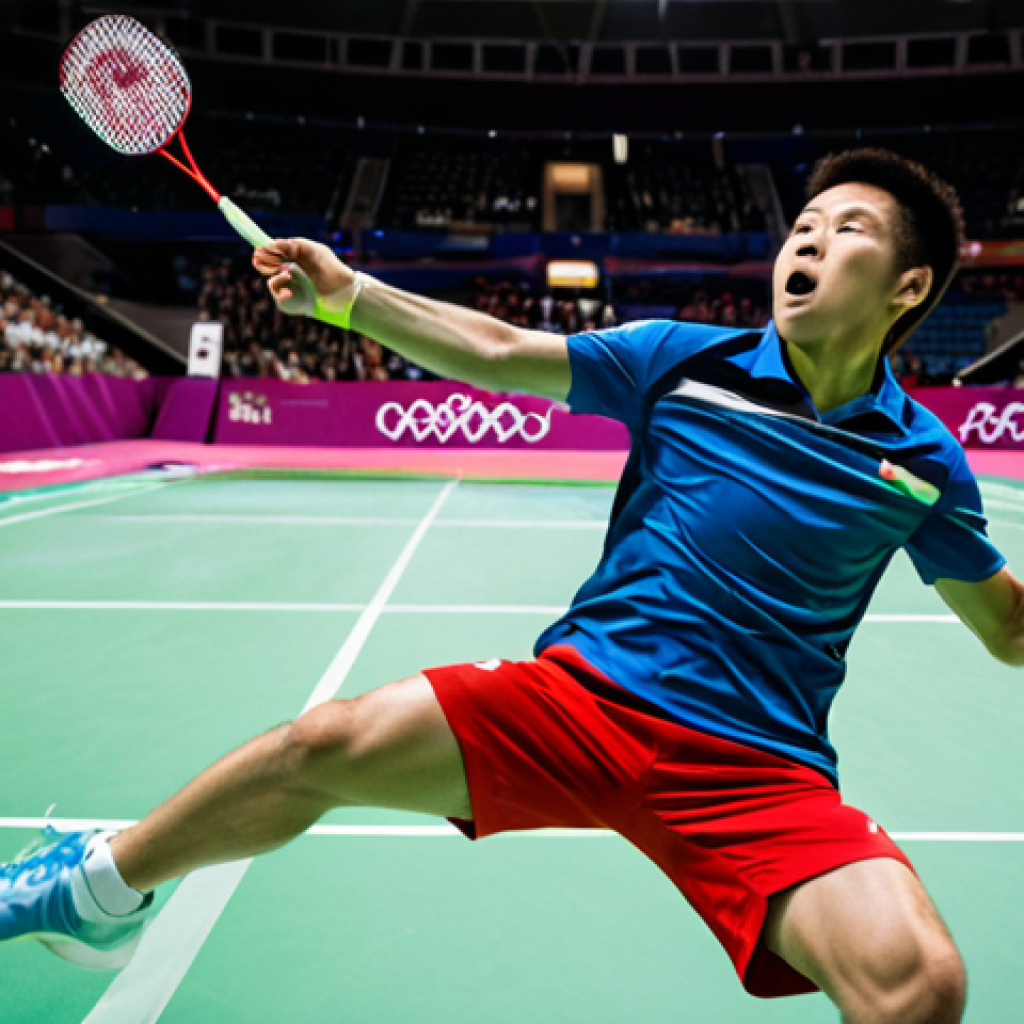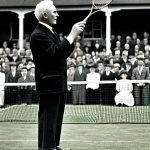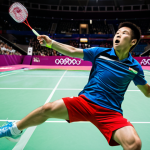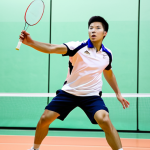You know, there’s something absolutely electrifying about watching Olympic badminton. It’s far more than just a casual backyard game; it transforms into an intense ballet of breathtaking power, pinpoint precision, and incredible agility.
I’ve always been captivated by how players seem to defy gravity, smashing shuttles at speeds that feel impossible, then dropping them feather-light over the net with such finesse.
This sport demands not only peak physical conditioning but also a razor-sharp tactical mind, pushing athletes to constantly innovate their strategies, especially with the rise of data analytics and personalized training regimes seen in recent years.
It’s truly a demanding yet mesmerizing display of human limits. Let’s find out precisely what makes it so special.
You know, there’s something absolutely electrifying about watching Olympic badminton. It’s far more than just a casual backyard game; it transforms into an intense ballet of breathtaking power, pinpoint precision, and incredible agility.
I’ve always been captivated by how players seem to defy gravity, smashing shuttles at speeds that feel impossible, then dropping them feather-light over the net with such finesse.
This sport demands not only peak physical conditioning but also a razor-sharp tactical mind, pushing athletes to constantly innovate their strategies, especially with the rise of data analytics and personalized training regimes seen in recent years.
It’s truly a demanding yet mesmerizing display of human limits. Let’s find out precisely what makes it so special.
The Unseen Arena: Where Power Meets Finesse

When you first tune into an Olympic badminton match, you might just see two athletes hitting a shuttlecock back and forth. But trust me, once you peel back that initial layer, you begin to grasp the sheer, unadulterated athleticism on display.
It’s not just about brute strength; it’s about channeling that power through a razor-thin racket face with such incredible speed and accuracy that it beggars belief.
I remember watching Viktor Axelsen, and the way he generates power from what looks like such a fluid, almost effortless movement, it’s pure poetry in motion.
His smashes aren’t just fast; they’re precise, hitting lines that seem physically impossible. Then, in the very next breath, he might execute a delicate drop shot that kisses the net and falls dead.
This juxtaposition of explosive power and feather-light touch is what truly defines the Olympic game, pushing players to their physical limits across every muscle group.
It’s a full-body workout executed at breakneck speed for sometimes an hour or more, demanding endurance that rivals marathon runners, yet with the explosive bursts of a sprinter.
Mastering Explosive Agility and Endurance
It’s easy to underestimate the physical demands until you’ve tried to replicate even a fraction of what these athletes do. They aren’t just running; they’re lunging, jumping, twisting, and rotating, often changing direction in a split second.
The speed of play in Olympic badminton is staggering, with rallies often lasting for many shots, each one requiring maximum effort. I’ve heard coaches talk about how a single match can feel like running several kilometers in sprints, all while maintaining perfect hand-eye coordination and tactical awareness.
Players train for years, building up incredible leg strength for those powerful jumps and lunges, core stability for rotational power, and shoulder and arm strength for the explosive smashes.
It’s an exhausting dance, a relentless pursuit of the next point that tests their cardiovascular system to its absolute maximum, often pushing them to the brink of collapse but then seeing them rebound with incredible resilience for the next rally.
The Art of the Deceptive Touch
Beyond the raw power, there’s an undeniable artistry to the game’s finesse. The subtle wrist movements, the barely perceptible changes in racket face angle, the way a player can make you believe they’re smashing hard only to send a delicate net shot drifting over.
This level of deception is what separates the good from the great. I once tried to mimic a simple net shot I saw Carolina Marín execute, and I ended up sending the shuttle halfway up the wall.
Her touch is so exquisite, so precise, that it looks deceptively simple. It’s about touch, feel, and an almost intuitive understanding of how the shuttle reacts to every slight variation in contact.
This is where hours of practice in specific shot drills truly pay off, refining muscle memory until these intricate shots become second nature under immense pressure.
It’s a testament to their dedication, turning something so complex into something that appears effortless.
The Psychological Duel: Minds as Sharp as the Shuttle
Forget just physical prowess; Olympic badminton is as much a battle of wits as it is of athleticism. Every single point is a chess match, with players constantly trying to read their opponent, anticipate their next move, and then execute a strategy to counter it or exploit a weakness.
I’ve always found this mental aspect absolutely fascinating. You can see it in their eyes, the intense focus, the split-second decision-making. A player might set up a rally with a series of clears, drawing their opponent to the back, only to suddenly drop a shot to the net, knowing their opponent will be out of position.
It’s a high-stakes game of cat and mouse, where misdirection and calculated risks are just as important as powerful smashes. The ability to stay calm under immense pressure, especially when the score is tight and a gold medal is on the line, is what truly separates the champions from the rest.
Reading the Opponent: A Silent Conversation
Elite badminton players possess an uncanny ability to “read” their opponents. They pick up on subtle cues: a slight shift in weight, the angle of the racket, even a fleeting glance.
I remember watching a match where a player consistently anticipated their opponent’s cross-court drops simply by observing their initial body rotation.
It’s a silent conversation unfolding on court, a constant exchange of information that dictates every move. This isn’t just about raw talent; it’s about years of experience, studying opponents’ habits, understanding their preferred shots, and identifying their weaknesses.
They analyze patterns of play, tendencies under pressure, and even physical tells, all while moving at lightning speed. It’s a deep, intuitive understanding of human behavior under extreme duress, transforming every rally into a psychological puzzle.
The Pressure Cooker: Mental Fortitude in Clutch Moments
There are moments in Olympic badminton that are etched into my memory – those nail-biting, deuce-point rallies in the third game of a major final. This is where mental fortitude shines brightest.
The crowd is roaring, the stakes are unimaginable, and every shot feels like it carries the weight of the world. I’ve seen players who were technically brilliant crumble under this pressure, and others, perhaps less flashy, who possessed an unshakeable resolve, pull off incredible comebacks.
It’s about resilience, the ability to reset after a mistake, to not let a bad call or a missed shot derail your focus. The champions are those who can not only perform under pressure but thrive in it, turning adversity into motivation.
This mental toughness, the ability to control emotions and maintain focus amidst chaos, is arguably as critical as any physical skill in the pursuit of Olympic gold.
Decoding the Shuttle: Equipment, Strategy, and a Dash of Deception
The shuttlecock itself, seemingly just a feathery projectile, is an engineering marvel that dictates much of the game’s unique flow and strategy. Unlike a tennis ball, its aerodynamic properties mean it slows down significantly after a hard hit, allowing for those incredible, gravity-defying smashes to be followed by delicate net shots.
Then there are the rackets, evolving constantly with new materials and designs. When I upgraded my own racket, even just to a mid-range carbon fiber one, I could immediately feel the difference in power and control.
Imagine what the pros are using! This combination of specialized equipment and nuanced strategy creates a playing field where every detail matters, from the string tension on a racket to the precise angle of a clear.
It’s a science as much as it is a sport, demanding players become experts not just in hitting, but in understanding the physics of their game.
The Physics of the Feathered Beast
It’s wild how much thought goes into the design of a shuttlecock. Made from goose feathers (or synthetic alternatives), their unique shape ensures high initial speed but rapid deceleration, which is precisely why long rallies are possible and why players can execute such varied shots.
I recall reading an article about how the specific flight path of a shuttle allows for the steep angle of smashes that makes them so hard to return, or the floaty arc of a high clear that gives players time to recover.
This flight behavior opens up a vast tactical playbook. If the shuttle flew like a baseball, badminton would be an entirely different, perhaps less nuanced, sport.
The weight distribution, the angle of the feathers – all these small details contribute to its distinctive trajectory, allowing for the deep clears, the deceptive drops, and the blistering smashes that make the sport so dynamic.
The Tactical Blueprint: Beyond Just Hitting Hard
While a powerful smash is thrilling, it’s often the strategy *behind* the smash that wins the point. Players aren’t just hitting the shuttle; they’re placing it, drawing their opponent out of position, setting up the next shot, anticipating their opponent’s return.
I often tell my friends that watching elite badminton is like watching a highly complex conversation unfolding in real-time. It’s about manipulating space, exploiting angles, and creating openings.
A well-executed cross-court slice can open up an entire side of the court for a follow-up kill. It’s not uncommon to see players deliberately hit a slightly weaker shot to lure their opponent in, only to then unleash a devastating smash.
This intricate dance of offense and defense, deception and execution, is what makes the sport so endlessly compelling. It’s not about being the strongest, but often about being the smartest and most adaptable on court.
Beyond the Court: The Global Pulse of Olympic Badminton
Badminton’s journey from a backyard pastime to a global Olympic phenomenon is genuinely inspiring. When you see stadiums packed with fans, from Jakarta to London, all roaring for their favorite players, you realize this isn’t just a niche sport.
It’s a vibrant, living culture. I’ve always been fascinated by how different nations approach the game, each bringing their unique styles and strengths.
The precision and discipline often associated with East Asian players, the flair and aggression from some European athletes – it creates this incredible tapestry of talent.
The Olympics act as a showcase, elevating these athletes to global stardom and inspiring countless youngsters to pick up a racket, dreaming of their own moment on that grand stage.
It truly feels like a global family united by the love of the game.
Cultural Styles and Global Dominance
It’s undeniable that certain regions have traditionally dominated the badminton world. Countries like China, Indonesia, Malaysia, and Denmark have consistently produced world-class players.
But what’s really interesting is observing the distinct playing styles that emerge from these different cultures. For instance, you might see a strong emphasis on consistent defense and relentless attack from some Asian powerhouses, while European players often exhibit a more varied, all-court game with powerful smashes.
I remember attending a live tournament where the contrasting styles were so apparent, and it made the matches even more thrilling. This global diversity of playing styles not only makes the sport more exciting to watch but also pushes players to adapt and innovate, constantly refining their own game against a wide array of formidable opponents.
The Olympic Dream: Inspiring the Next Generation
For many young athletes, the Olympics represent the pinnacle of their sporting aspirations. Seeing their heroes compete on that global stage, representing their country with pride, ignites a fire within them.
I’ve spoken to young players who started playing precisely because they saw someone like Lin Dan or Carolina Marín achieve Olympic glory. The visibility provided by the Games is invaluable, transforming athletes into household names and attracting new fans and participants to the sport.
It’s not just about winning medals; it’s about creating role models, fostering passion, and building a legacy. The buzz around the Olympic badminton tournaments, the sheer excitement and drama, is contagious, proving that this fast-paced, skillful sport is captivating audiences worldwide and continuing to grow its influence.
| Aspect | Description & Impact | Notable Example (Player Trait) |
|---|---|---|
| Physical Acumen | Combines explosive power, agility, and endurance; requires full-body conditioning for rapid movements and sustained rallies. | Viktor Axelsen’s powerful smashes and court coverage. |
| Mental Fortitude | Ability to stay calm, strategize, and execute under immense pressure; critical for clutch moments and comebacks. | Carolina Marín’s unwavering focus and fighting spirit. |
| Technical Precision | Mastery of diverse shots (smash, drop, clear, slice); requires exquisite touch and control over the shuttle’s flight. | Kento Momota’s deceptive net play and precise placement. |
| Strategic Depth | Reading opponents, anticipating moves, setting up points; involves a complex “chess match” on court. | Lee Chong Wei’s ability to manipulate rallies and create openings. |
My Own Journey: From Spectator to True Believer
Before I truly delved into Olympic badminton, I’ll admit I probably shared the common misconception that it was just a leisurely backyard activity. Oh, how wrong I was!
My conversion happened quite unexpectedly during the last Olympics. I was flipping through channels, caught a glimpse of a men’s singles match, and found myself utterly mesmerized.
The speed, the athleticism, the sheer intensity – it was nothing like I had imagined. I remember being glued to my screen for hours, cheering for players I didn’t even know, totally swept up in the drama of each rally.
It quickly became apparent that this wasn’t just a game; it was an incredibly demanding sport, a spectacle of human physical and mental prowess that truly gets your heart racing.
My experience taught me that sometimes the greatest joys are found in discovering something entirely new, something you never thought would capture your imagination so completely.
The Moment It Clicked: A Personal Revelation
That pivotal moment for me was during a particularly grueling rally between two top contenders. The shuttle was flying at impossible speeds, players were diving and leaping, and then, suddenly, a perfectly executed drop shot sealed the point.
My jaw literally dropped. I felt a rush of adrenaline just watching it. It wasn’t just the athleticism; it was the intelligence behind the shot, the years of practice condensed into that one perfect execution.
It felt like watching a blend of high-speed chess and a ballet, and from that moment on, I was hooked. I immediately went online, looking up player profiles, match highlights, and even the rules of the game.
It was a complete paradigm shift in my perception of badminton, transforming it from a casual curiosity into a genuine passion. That feeling of surprise and awe is something I constantly chase when discovering new aspects of sports.
Embracing the Badminton Community
Since then, my interest hasn’t waned. In fact, it’s only deepened. I started following more tournaments, joined online forums to discuss matches, and even ventured to a local sports center to hit some shuttles myself (with far less grace, I assure you!).
What I found was a welcoming and passionate community, eager to share their love for the sport. It’s been incredibly rewarding to connect with fellow enthusiasts, exchanging theories on tactics, celebrating victories, and commiserating over losses.
This journey, from a passive observer to an active participant in the badminton conversation, has been one of the most unexpected and delightful experiences of my life.
It really highlights how sports, especially at the Olympic level, can bring people together and spark new interests you never knew you had.
The Evolving Game: Why Today’s Badminton is Tomorrow’s Legacy
Badminton isn’t a static sport; it’s constantly evolving, pushed forward by incredible athletes, innovative coaching, and technological advancements. What was once considered the peak of performance a decade ago is now commonplace, as players push the boundaries of speed, power, and strategy.
We’re seeing more aggressive play, more diverse shot-making, and even more sophisticated approaches to physical conditioning and recovery. The continuous pursuit of excellence means that every Olympic cycle brings new stars, new records, and new ways of playing the game that keeps it fresh and exciting.
It’s a testament to the human spirit of innovation, always striving to be faster, stronger, and smarter, laying down a legacy for generations to come.
Innovations in Training and Technology
Modern training methodologies have revolutionized how badminton players prepare for the Olympics. Gone are the days of just hitting shuttles for hours; now, it’s highly specialized, science-backed training.
I’ve seen documentaries detailing how top athletes utilize advanced analytics to pinpoint weaknesses, motion capture technology to refine technique, and personalized strength and conditioning programs to optimize their physical peak.
Even the equipment, from lighter, more durable rackets to specialized footwear, plays a crucial role. This fusion of athleticism and cutting-edge science is creating a new breed of badminton player, one who is not only incredibly talented but also meticulously prepared down to the smallest detail, ensuring they arrive at the Games in prime condition to perform at their absolute best.
The Rise of New Stars and Diverse Talent
One of the most exciting aspects of Olympic badminton is the constant emergence of new talent from all corners of the globe. While certain nations have historically dominated, the sport’s growing popularity means we’re consistently seeing players from unexpected regions break into the elite ranks.
This influx of diverse playing styles and fresh perspectives pushes the established order, creating even more competitive and unpredictable tournaments.
I find it exhilarating to witness these rising stars challenge the legends, often bringing a raw energy and innovative approach that injects new life into the game.
This dynamic shift ensures that every Olympic Games presents a fresh narrative, new rivalries, and the potential for groundbreaking performances, keeping us on the edge of our seats year after year.
Wrapping Up
Stepping into the world of Olympic badminton is truly an experience unlike any other. It shatters preconceptions, revealing a sport of extraordinary depth, where mind and body unite in a mesmerizing dance of power, precision, and strategic genius. From the lightning-fast smashes to the delicate net drops, every rally is a testament to human potential, pushing athletes to their absolute limits. If you’ve never fully appreciated it, I implore you to tune into the next major tournament – I guarantee you’ll find yourself captivated, just as I did. It’s a spectacular show of athletic artistry that truly deserves its place on the world’s biggest stage.
Handy Tips & Quick Facts
1. Fastest Racket Sport: The shuttlecock can reach speeds exceeding 300 mph (over 480 km/h) off the racket during a smash, making it the fastest recorded object in any racket sport.
2. Scoring
3. Court Dimensions: The badminton court is 13.4 meters (44 feet) long and 6.1 meters (20 feet) wide for doubles, and 5.18 meters (17 feet) wide for singles, making it a relatively compact yet intensely active space.
4. Olympic Debut: Badminton became an official Olympic sport at the 1992 Barcelona Games, though it was a demonstration sport in 1972 and 1988.
5. Feather Count: A standard shuttlecock typically has 16 goose feathers, carefully arranged to ensure a consistent flight path, which is crucial for the game’s unique aerodynamics.
Key Takeaways
Olympic badminton is a powerhouse sport demanding peak physical conditioning, including explosive power, agility, and endurance. It’s equally a mental battle, requiring sharp tactical minds, deception, and unwavering fortitude under pressure. The unique physics of the shuttlecock and constant innovation in equipment and training elevate the game. Beyond the court, it’s a globally diverse and inspiring spectacle, consistently captivating audiences and fostering new talent worldwide.
Frequently Asked Questions (FAQ) 📖
Q: Beyond the casual backyard game, what genuinely sets Olympic badminton apart as such an electrifying display of power, precision, and agility?
A: Oh, man, it’s a whole different beast, honestly. When you’re watching Olympic badminton, you’re not seeing a leisurely tap-tap back and forth. You’re witnessing pure, explosive athleticism.
I mean, I’ve seen players leap and smash the shuttlecock at speeds that make your jaw drop – we’re talking over 300 miles an hour, which is just insane!
But then, in the very next breath, they’ll execute a drop shot so delicate, it barely clears the net, landing with pinpoint accuracy. It’s this incredible contrast of raw power and unbelievable finesse that truly elevates it.
And the agility? They’re practically dancing on air, changing direction in an instant to cover the entire court. It’s not just hitting a bird over a net; it’s a full-body, high-speed chess match that leaves you breathless just watching.
Q: How have the recent advancements, like data analytics and personalized training regimes, really reshaped the strategic landscape and athlete preparation in Olympic badminton?
A: That’s where things get super interesting and, frankly, why the game keeps evolving. Back in the day, it felt more about raw talent and gut instinct. Now, with data analytics, it’s like a whole new layer of strategy has opened up.
Coaches and players are poring over hours of video, dissecting opponents’ tendencies, identifying their preferred shots under pressure, even tracking their own fatigue patterns.
It’s not just guessing; it’s calculated. And personalized training? That’s massive.
Athletes aren’t just doing generic gym work anymore. Their regimes are tailored to their unique biomechanics, focusing on strengthening specific muscles for those lightning-fast lunges or improving their recovery time between points.
I genuinely believe this scientific approach is what’s pushing human limits in the sport, making every smash and every deceptive flick a highly optimized, strategic decision.
Q: Given the immense physical demands, what are some of the unique mental challenges Olympic badminton players face, and how do they manage to overcome them on court?
A: People often focus on the physical grind, which is undeniably huge, but the mental game in Olympic badminton is just as brutal, if not more so. Think about it: you’re making split-second decisions at incredible speeds, often under immense pressure like a match-point rally.
Maintaining focus through those incredibly long, grueling points, especially when you’re physically exhausted, is a monumental task. I remember watching a player once, down by a significant margin, just refusing to break, point after point, until they clawed their way back.
It’s that sheer mental fortitude, that unwavering belief, that sets the top players apart. They’re constantly anticipating their opponent, trying to outsmart them, and dealing with the inevitable mistakes without letting frustration spiral.
It’s like a constant internal dialogue of staying calm, adapting on the fly, and summoning that inner resilience to push through even when every fiber of your body is screaming to quit.
📚 References
Wikipedia Encyclopedia
구글 검색 결과
구글 검색 결과
구글 검색 결과
구글 검색 결과
구글 검색 결과



